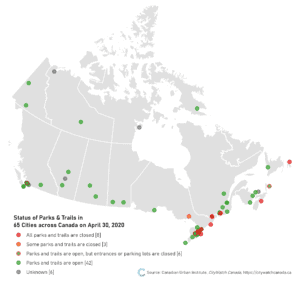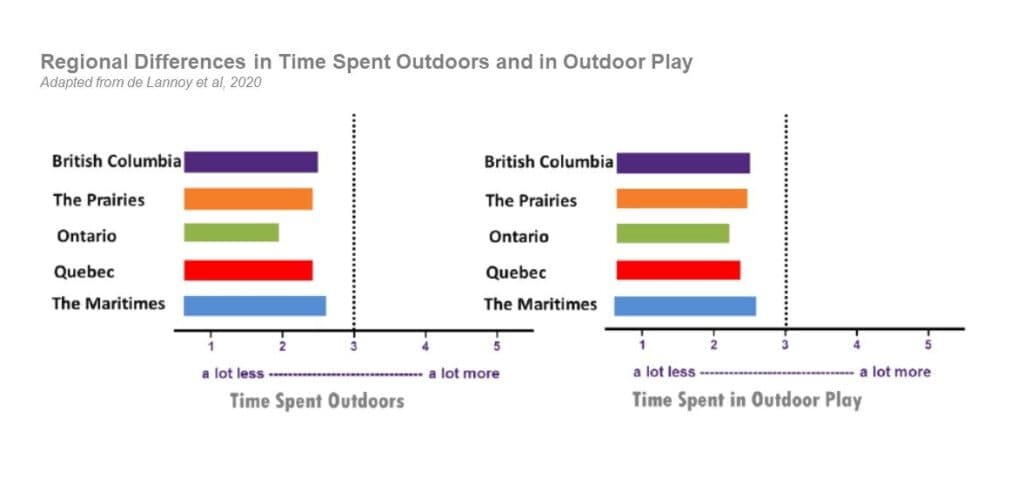
Regional differences in access to the outdoors and outdoor play of Canadian children and youth during the COVID-19 outbreak
To reduce the spread of COVID-19, public health authorities across the country have recommended that Canadians keep their distance, wash their hands, and stay home. To enforce these measures early in the pandemic, restrictions on outdoor behaviour were implemented, limiting access to parks, playgrounds, conservation areas and recreational outdoor spaces. Counterbalancing efforts to create more space outdoors, such as making select roadways car-free, focused primarily on active transportation and exercise. Far fewer efforts were made to facilitate children’s outdoor play.
The consequence, as highlighted in a national survey commissioned by ParticipACTION conducted in April 2020, was that children were playing outdoors far less than before the COVID-19 outbreak.
The severity of these restrictions, as well as counterbalancing efforts, varied substantially by province. In a commentary recently published by the Canadian Journal of Public Health, we explored regional differences in COVID-19-related restrictions on access to the outdoors and compared these differences to regional changes in outdoor play of Canadian children and youth.
In our commentary, we observed that some of the most restrictive measures on access to the outdoors were found in Ontario; Oakville completely banned access to municipal parks, Toronto was the last major city in the country to implement road closures to facilitate safe outdoor activity, and Ottawa limited park use to ‘walk-through only’ purposes, essentially banning play from these spaces, and heavily ticketed those who deviated from that rule. Vancouver, by comparison, was one of the first places in the country to institute measures to promote safe access to the outdoors by banning car access to Stanley Park. Alberta Provincial Parks permitted access to visitors arriving by foot, bicycle, or horse, with the Alberta Recreation and Parks Association stepping up early with a statement outlining efforts to continue working with the Alberta government to ensure continued safe access to parks. Manitoba also kept their parks open and Prince Edward Island closed their park services, but permitted day-use access to trails.
The map below, provided by the Canadian Urban Institute, echoes the pattern of restrictions on access to the outdoors that we observed with the greatest restrictions observed in Ontario, and the least in Western Canada.

We then explored regional changes in outdoor play behaviour of Canadian children and youth using survey data collected from a sample of 1,472 parents of children and youth aged 5-17 years from across the country. We found that in all regions there was a decrease in time spent outdoors and in outdoor play where Ontario experienced the greatest decline in both time spent outdoors and in outdoor play.

It is unsurprising that the province with the most stringent restrictions on access to the outdoors had the greatest decline in time spent outdoors and in outdoor play among children and youth. While the recommendations to stay apart and stay at home have clearly been effective in flattening the curve, it is debatable whether restrictions on access to the outdoors were warranted, given the benefits of the outdoors in promoting a healthy immune system and maintaining physical and mental health. The collateral damage of these restrictions on childhood access to outdoor play and on children’s physical, emotional, and social wellbeing is a major public health concern.
Therefore, preserving and promoting access to outdoor play by keeping public green spaces open, and promoting outdoor play in schools should be a top public health priority as we continue to navigate the pandemic, and as we look forward to a brighter and healthier future for all.
Read the full article here: Louise de Lannoy, Ryan E. Rhodes, Sarah A. Moore, Guy Faulkner & Mark S. Tremblay. Regional differences in access to the outdoors and outdoor play of Canadian children and youth during the COVID-19 outbreak. Canadian Journal of Public Health. (2020).

